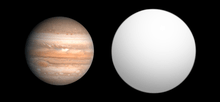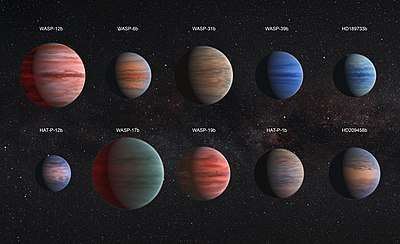WASP-6b
WASP-6b is an extrasolar planet approximately 600 light years away in the constellation Aquarius. It was discovered in 2008, by the WASP survey, by astronomical transit across its parent star WASP-6. This planet orbits only 4% that of Earth-Sun distance. The planet has mass half that of Jupiter, but its insolation has forced a thermal expansion of its radius over that of Jupiter.[1] The planet is an inflated Hot Jupiter.[1][2] Starspots on the host star WASP-6 helped to refine the measurements of the mass and the radius of the planet.[3]
 Size comparison of WASP-6b with Jupiter. | |
| Discovery | |
|---|---|
| Discovered by | Gillon et al. (SuperWASP) |
| Discovery site | SAAO |
| Discovery date | April 1, 2008 |
| Transit | |
| Orbital characteristics | |
| Apastron | 0.0444 AU (6,640,000 km) |
| Periastron | 0.0398 AU (5,950,000 km) |
| 0.0421+0.0008 −0.00013 AU | |
| Eccentricity | 0.054+0.018 −0.015 |
| 3.361006+2.2e-6 −3.5e-6 d | |
| Inclination | 88.47+0.65 −0.47 |
| 1.7+0.18 −0.22 | |
| Star | WASP-6 |
| Physical characteristics | |
Mean radius | 1.224+0.051 −0.052 RJ |
| Mass | 0.503+0.019 −0.038 MJ |
Mean density | 364 kg/m3 (614 lb/cu yd) |
| 0.886 g | |
| Temperature | 1293 |
Naming
In 2019 the IAU announced that WASP-6 and its planet WASP-6b would be given official names chosen by school children from The Dominican Republic.[4][5] The planet WASP-6b is named Boinayel. Boinayel the god of rain that fertilizes the soil.[6][7]
Orbit
The study in 2012, utilizing a Rossiter–McLaughlin effect, have determined the planetary orbit is probably aligned with the equatorial plane of the star, misalignment equal to -11+18
−14°.[8]
Atmosphere
Observations with the Magellan Telescope in 2013 studied the transits in different wavelengths. The study observed a decrease in transit depth as a function of wavelength, characteristic of a scattering haze. No spectral features were detected.[9] A study in 2015 using Hubble Space Telescope and Spitzer Space Telescope data also found evidence of a scattering haze, but it found tentative evidence for sodium and potassium.[10] A study in 2015, using the Spitzer Space Telescope detected the eclipse of the planet behind the host star. The study found a dayside temperature of 1235+70
−77 K (962+70
−77 °C) and 1118+68
−74 K (845+68
−74 °C) for the 3.6 and 4.5 μm channels respectively.[11] A study from 2019 using data from ground based observatories, such as the Very Large Telescope and space telescopes, such as the Transiting Exoplanet Survey Satellite analysed the atmosphere of WASP-6b. This study confirmed the presence of sodium and potassium in the atmosphere. The study also found water vapour in the atmosphere of the planet. The study came to the conclusion that despite the presence of a haze in the atmosphere of WASP-6b, the planet remains a favourable object for future atmospheric characterisation with missions such as JWST.[12][2]
See also
- SuperWASP or WASP planetary search program
References
- Gillon; Anderson, D. R.; Triaud, A. H. M. J.; Hellier, C.; Maxted, P. F. L.; Pollaco, D.; Queloz, D.; Smalley, B.; et al. (2009). "Discovery and characterization of WASP-6b, an inflated sub-Jupiter mass planet transiting a solar-type star". Astronomy and Astrophysics. 501 (2): 785–792. arXiv:0901.4705. Bibcode:2009A&A...501..785G. doi:10.1051/0004-6361/200911749.
- Carter, Aarynn L.; Nikolov, Nikolay; Sing, David K.; Alam, Munazza K.; Goyal, Jayesh M.; Mikal-Evans, Thomas; Wakeford, Hannah R.; Henry, Gregory W.; Morrell, Sam; López-Morales, Mercedes; Smalley, Barry; Lavvas, Panayotis; Barstow, Joanna K.; Muñoz, Antonio García; Wilson, Paul A.; Gibson, Neale P. (2020). "Detection of Na, K and H2O in the hazy atmosphere of WASP-6b". Monthly Notices of the Royal Astronomical Society. 494 (4): 5449–5472. arXiv:1911.12628. doi:10.1093/mnras/staa1078.
- Tregloan-Reed, Jeremy; Southworth, John; Burgdorf, M.; Novati, S. Calchi; Dominik, M.; Finet, F.; Jørgensen, U. G.; Maier, G.; Mancini, L.; Prof, S.; Ricci, D.; Snodgrass, C.; Bozza, V.; Browne, P.; Dodds, P.; Gerner, T.; Harpsøe, K.; Hinse, T. C.; Hundertmark, M.; Kains, N.; Kerins, E.; Liebig, C.; Penny, M. T.; Rahvar, S.; Sahu, K.; Scarpetta, G.; Schäfer, S.; Schönebeck, F.; Skottfelt, J.; Surdej, J. (2015-06-21). "Transits and starspots in the WASP-6 planetary system". Monthly Notices of the Royal Astronomical Society. 450 (2): 1760–1769. arXiv:1503.09184. Bibcode:2015MNRAS.450.1760T. doi:10.1093/mnras/stv730. ISSN 0035-8711.
- "NameExoWorlds". 2019. Retrieved 6 September 2019.
- "Naming". 2019. Retrieved 6 September 2019.
- "Approved names". NameExoworlds. Retrieved 2020-01-02.
- "International Astronomical Union | IAU". www.iau.org. Retrieved 2020-01-02.
- Obliquities of Hot Jupiter host stars: Evidence for tidal interactions and primordial misalignments, 2012, arXiv:1206.6105
- Jordán, Andrés; Espinoza, Néstor; Rabus, Markus; Eyheramendy, Susana; Sing, David K.; Désert, Jean-Michel; Bakos, Gáspár Á.; Fortney, Jonathan J.; López-Morales, Mercedes; Maxted, Pierre F. L.; Triaud, Amaury H. M. J.; Szentgyorgyi, Andrew (2013-11-13). "A GROUND-BASED OPTICAL TRANSMISSION SPECTRUM OF WASP-6b". The Astrophysical Journal. 778 (2): 184. arXiv:1310.6048. Bibcode:2013ApJ...778..184J. doi:10.1088/0004-637x/778/2/184. ISSN 0004-637X.
- Nikolov, N.; Sing, D. K.; Burrows, A. S.; Fortney, J. J.; Henry, G. W.; Pont, F.; Ballester, G. E.; Aigrain, S.; Wilson, P. A.; Huitson, C. M.; Gibson, N. P.; Désert, J.-M.; Lecavelier des Etangs, A.; Showman, A. P.; Vidal-Madjar, A.; Wakeford, H. R.; Zahnle, K. (2015-02-11). "HST hot-Jupiter transmission spectral survey: haze in the atmosphere of WASP-6b". Monthly Notices of the Royal Astronomical Society. 447 (1): 463–478. arXiv:1411.4567. Bibcode:2015MNRAS.447..463N. doi:10.1093/mnras/stu2433. ISSN 0035-8711.
- Kammer, Joshua A.; Knutson, Heather A.; Line, Michael R.; Fortney, Jonathan J.; Deming, Drake; Burrows, Adam; Cowan, Nicolas B.; Triaud, Amaury H. M. J.; Agol, Eric; Desert, Jean-Michel; Fulton, Benjamin J.; Howard, Andrew W.; Laughlin, Gregory P.; Lewis, Nikole K.; Morley, Caroline V.; Moses, Julianne I.; Showman, Adam P.; Todorov, Kamen O. (September 2015). "Spitzer Secondary Eclipse Observations of Five Cool Gas Giant Planets and Empirical Trends in Cool Planet Emission Spectra". Astrophysical Journal. 810 (2): 118. Bibcode:2015ApJ...810..118K. doi:10.1088/0004-637X/810/2/118. ISSN 0004-637X.
- waspplanets (2019-12-08). "The atmosphere of the inflated hot Jupiter WASP-6b". WASP Planets. Retrieved 2020-01-01.
